No products in the cart.
NEWS
Thriving Fruit Trees in Northern Vietnam: Top Varieties for Your Garden
Northern Vietnam boasts a climate and terrain exceptionally well-suited for cultivating a diverse array of delicious fruits. Many local and introduced fruit tree varieties currently offer significant economic value to farmers and provide delightful harvests for home gardeners. As experts in horticulture and agricultural support products at Biogarden.Asia, we understand the unique conditions of this region and are dedicated to helping you select and care for the most promising fruit trees. This article shares insights into the top fruit varieties known to thrive and flourish in the climate of Northern Vietnam.
Understanding the Climate and Soil of Northern Vietnam
The northern region of Vietnam, particularly the mountainous provinces, features incredibly diverse topography. This geographical variation creates numerous microclimates with distinct soil and weather conditions. This diversity is a major advantage, allowing for the cultivation of a wide range of fruit trees that possess unique and sometimes exceptional characteristics.
Furthermore, the abundant land resources available in the North provide a favorable environment for fruit trees to develop and expand cultivation areas. The relatively cool climate, combined with the varied soil types, supports the growth of many fruit species, including lychee, plum, kumquat, persimmon, kiwi, longan, pomelo, jackfruit, waxberry, and more. Selecting varieties specifically adapted to these conditions is key to successful cultivation.
Top Fruit Tree Varieties Flourishing in Northern Vietnam
While countless fruit varieties exist, some are exceptionally well-adapted to the climate of Northern Vietnam, making them easier to care for and often more cost-effective to grow. Biogarden.Asia highlights some of the most worthwhile fruit tree varieties to consider planting in this region today.
Jabuticaba (Myrciaria cauliflora)
Jabuticaba, or Brazilian Grape Tree, is an imported fruit tree that has gained significant popularity in Vietnam in recent years. Its fruit differs from conventional grapes as it doesn’t grow in clusters on vines. Instead, the glossy black, succulent grapes grow directly on the trunk and branches, creating a unique and aesthetically pleasing sight for ornamental growers. When ripe, the fruits turn black or dark purple, with white flesh typically containing four seeds. This species has a relatively short juvenile period, often bearing fruit within about 2 years of planting from seed in optimal conditions.
 Ripe Jabuticaba fruits growing directly on the tree trunk
Ripe Jabuticaba fruits growing directly on the tree trunk
Giant Red Flesh Sapodilla (Manilkara zapota ‘Giant Red’)
The Giant Red Flesh Sapodilla, also known as Giant Sapo, is a woody tree that can bear fruit approximately 2 years after planting and often produces year-round. Its oval-shaped fruits grow along the branches and trunk, appearing somewhat like flowers. The skin is rough and brown, resembling bark. The inner flesh is a deep orange color and is incredibly sweet when ripe. This is not only a rare fruit tree but also provides beauty and high nutritional value beneficial for health.
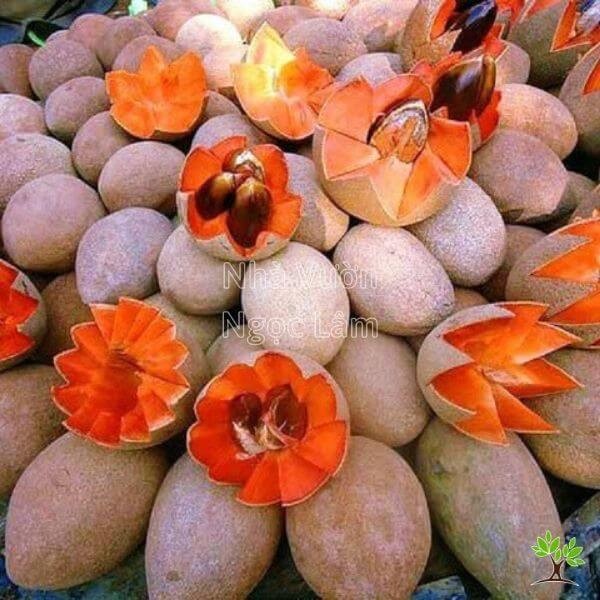 Close-up of vibrant orange flesh of a ripe Giant Red Flesh Sapodilla fruit
Close-up of vibrant orange flesh of a ripe Giant Red Flesh Sapodilla fruit
Ruby Guava (Psidium guajava ‘Ruby’)
Ruby Guava, also known as Red Flesh Guava, is a relatively easy variety to grow. It shows good resistance to pests and diseases and fruits quickly. The Ruby Guava fruit has very few seeds in its red flesh and is known for its crisp, delicious texture and flavor, making it highly popular in the market. It offers a sweet, slightly tart taste with a distinctive aroma, creating a delightful and appealing fruit. Ruby Guava is not only pleasant to eat but also provides significant nutritional value.
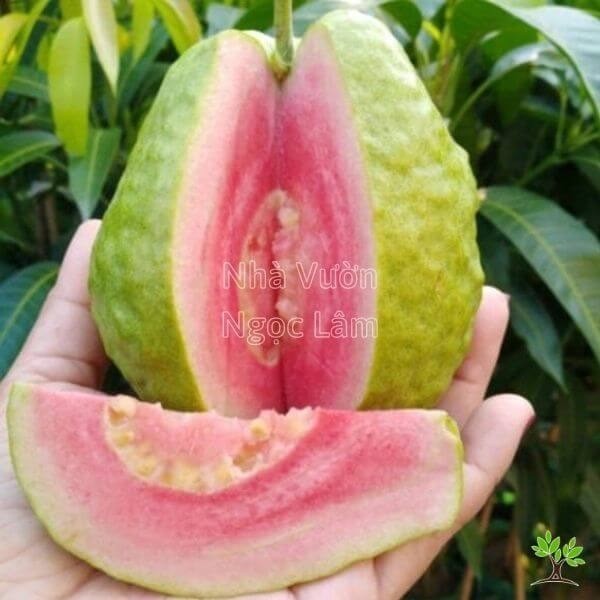
Brazilian Cherry (Eugenia uniflora)
Brazilian Cherry is a medium-sized cherry tree native to southern Brazil. Its fruits are small, purple to black, and have a sweet, slightly tangy flavor reminiscent of true cherries. The tree has a woody trunk and tends to grow primarily vertically with a slender shape. If you are seeking a fruit tree that is easy to grow under Vietnam’s climate conditions, Brazilian Cherry is an interesting choice.
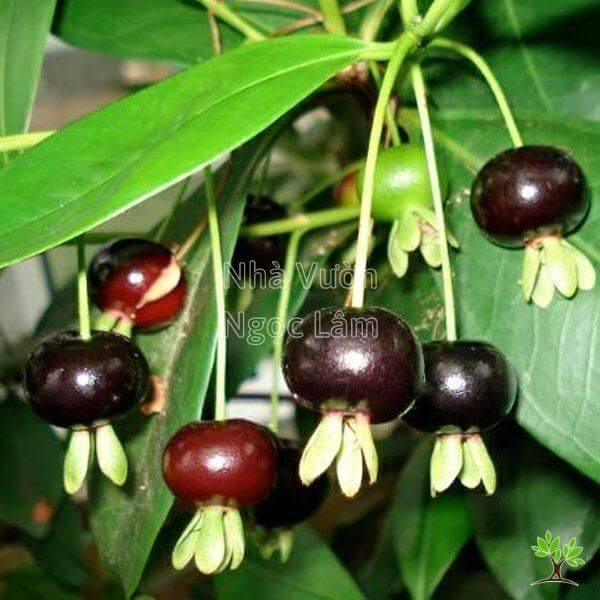 Cluster of small, dark purple Brazilian Cherry fruits hanging from a branch
Cluster of small, dark purple Brazilian Cherry fruits hanging from a branch
Durian Annona (Annona muricata ‘Durian Annona’)
Durian Annona is a woody tree primarily cultivated in tropical regions. Its flowers typically grow singly or in clusters of 2-4 at the branch tips or opposite the leaves. The flowers are pale yellow, narrow, thick, oblong, with triangular sepals. The Durian Annona fruit is quite large, with thin skin and white flesh containing few seeds. A distinctive feature is its firm flesh with a subtly sweet taste and a characteristic durian-like aroma.
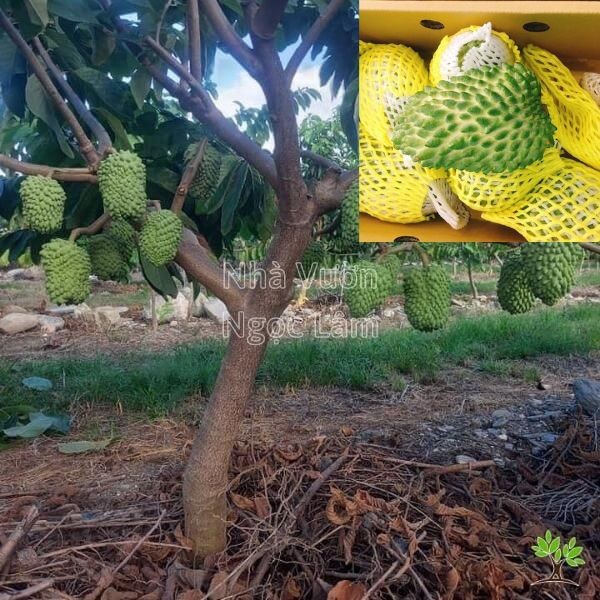 Close-up of a large, spiky green Durian Annona fruit on a branch
Close-up of a large, spiky green Durian Annona fruit on a branch
Pineapple Guava (Feijoa sellowiana)
Pineapple Guava is a unique fruit tree that is highly sought after in the current market. Its fruit shape is somewhat similar to the Taiwanese Pear Guava but is smaller and has greenish-blue skin. The Pineapple Guava fruit gradually turns yellowish-green when ripe, and its flesh is translucent and soft. The pulp is quite tender, with a sweet taste and a unique flavor different from other guava types. This aroma is a combination of the flavors of pineapple and apple.
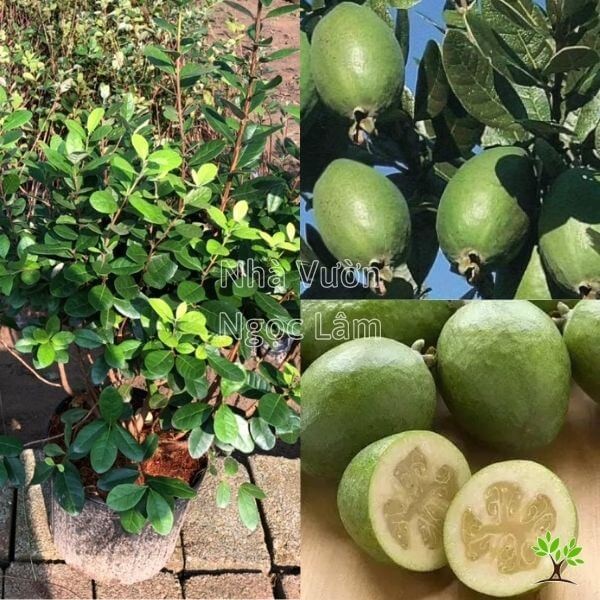 Green Pineapple Guava fruits hanging on a branch with green leaves
Green Pineapple Guava fruits hanging on a branch with green leaves
Seedless Lychee (Litchi chinensis ‘Seedless’)
Lychee is one of the most popular fruit tree varieties in the northern provinces of Vietnam. It is a staple crop that provides significant annual economic benefits for farmers in some areas. Recently, the seedless lychee variety has been gaining prominence in the market, creating a new sensation among fruit enthusiasts.
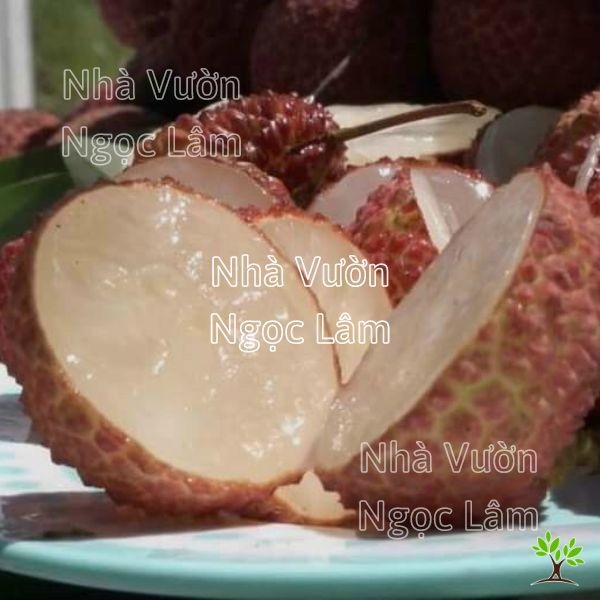 Harvested pile of reddish-pink seedless lychee fruits
Harvested pile of reddish-pink seedless lychee fruits
While not significantly different in appearance from traditional lychees, its biggest advantage is being seedless. Furthermore, the yield and quality of this lychee variety are notably superior. Consequently, its price is often around 20% higher than that of traditional lychees. Another advantage is that the tree grows quite tall with a wide canopy and dense foliage, providing excellent shade. This lychee variety is also quite resistant to pests and diseases, making it easier for farmers to cultivate, and is often considered one of the easiest fruit trees to grow in the region.
Peach Tree (Prunus persica)
Peach trees are an indispensable fruit tree variety in Northern Vietnam. Currently, many peach varieties are cultivated by orchard owners, bringing relatively high economic efficiency, with the Japanese Heavenly Peach variety being among the most profitable.
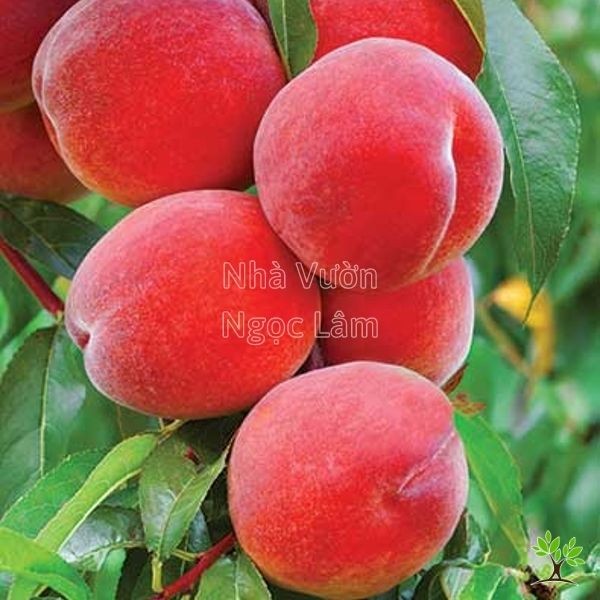 Round, reddish-pink Japanese Heavenly Peach fruits on a branch
Round, reddish-pink Japanese Heavenly Peach fruits on a branch
The Japanese Heavenly Peach tree can adapt well to cool climates and has good resistance to pests and diseases. This variety, originating from Japan, possesses strong growth characteristics and produces extremely high-quality fruit. Japanese Peaches are rich in nutrients beneficial to the body, such as protein and fat. They also contain various sugars and vitamins like B1, B2, C, and PP, along with minerals like iron, phosphorus, and calcium.
Hau Plum (Prunus salicina ‘Hau’)
Hau Plum is renowned as a famous fruit tree variety in Northern Vietnam for its delicious taste and is considered a specialty of Moc Chau. The consistently cool climate and fertile soil result in plums of exceptionally high quality, making it a prized gift of nature. Ripe Hau Plums have an attractive dark red color and an unforgettable sweet and tangy flavor.
 Pile of dark red Hau Plums, a specialty fruit from Moc Chau, Northern Vietnam
Pile of dark red Hau Plums, a specialty fruit from Moc Chau, Northern Vietnam
Hau Plum trees are widely planted by locals for their economic benefits and to provide shade. The plums also offer numerous nutritional benefits and are excellent for the body. All parts of the Hau Plum tree can be fully utilized: the roots help reduce heat and detoxify; the leaves help reduce fever; the seed kernels heal wounds; and the fruit has effects like preventing anemia.
Kumquat (Citrus japonica)
Kumquat, also known by various names like Hoàng bì, Đỗ mai, or Kim đạn tử, is a fruit tree variety widely grown in Northern Vietnam. It belongs to the citrus family and thus has an acidic nature.
Kumquats typically bear fruit in the summer. The fruit has a refreshing sour taste with a distinctive aroma, making it very palatable. The skin of the kumquat is thin and bright yellow, often with small green dots. Inside, the flesh is very fragrant, contains many seeds, and is divided into segments.
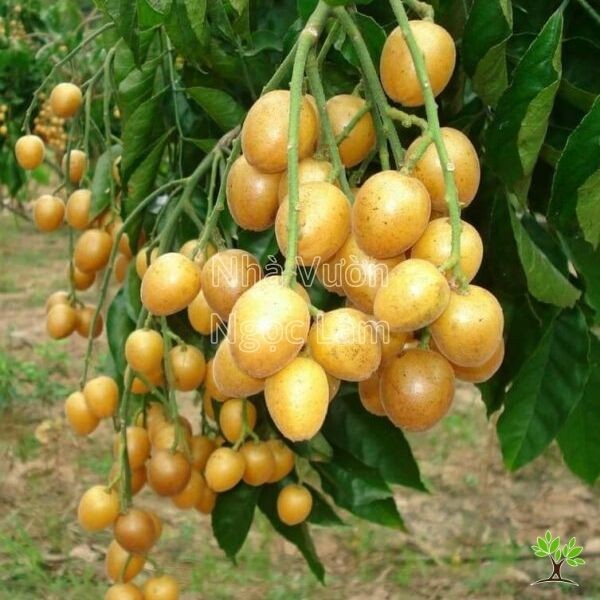 Branch of a Kumquat tree laden with small, oval yellow fruits
Branch of a Kumquat tree laden with small, oval yellow fruits
Kumquats are high in fiber and other substances like phosphorus, potassium, calcium, vitamin B2, vitamin C, and more. They are also considered a medicinal treasure in traditional medicine due to their ability to treat various ailments such as dry cough with phlegm, asthma, stomach pain, bloating, constipation, inflammation, menstrual regulation, and anemia.
Crispy Persimmon (Diospyros kaki ‘Crispy’)
Among the famous fruit trees of Northern Vietnam is the Crispy Persimmon. Crispy Persimmons are typically very astringent when green. However, when fully ripe, they develop a sweet taste with a slightly lingering sensation after eating, and a wonderfully crisp texture.
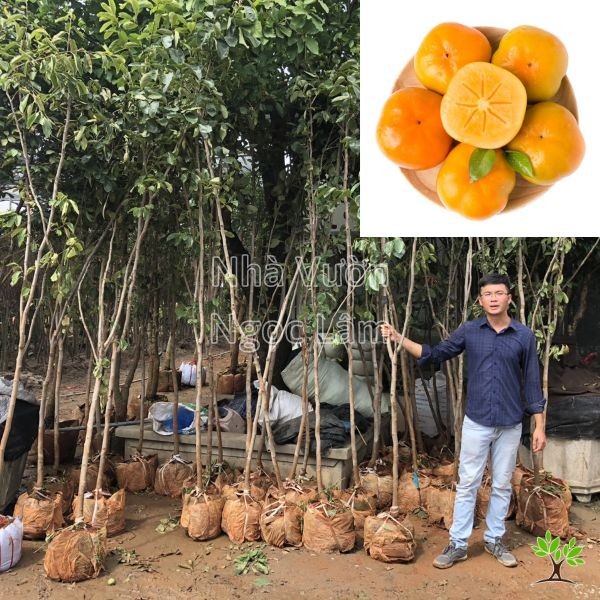 Several bright orange Crispy Persimmon fruits arranged together
Several bright orange Crispy Persimmon fruits arranged together
Crispy Persimmons contain surprisingly many nutrients, with the highest amounts being Vitamin A, B2, B6, C, fiber, and minerals like iron, calcium, carbohydrates, fructose, glucose, protein, sucrose, carotene, and more. In terms of nutrient content, especially minerals, the persimmon surpasses common fruits like pears, oranges, and apples.
Kiwi (Actinidia deliciosa)
Kiwi is an imported fruit variety that has successfully adapted and developed well in the soil and climate of the northern provinces. Recently, Kiwi cultivation has become increasingly widespread, with improvements leading to shorter flowering and fruiting times and consistently higher yield and quality.
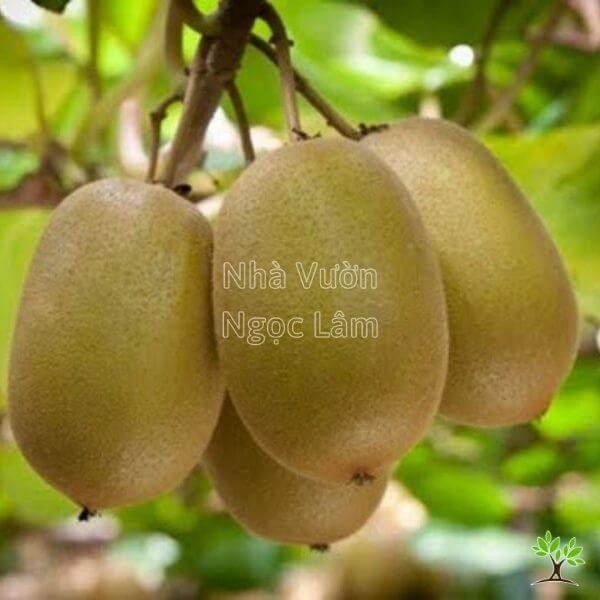 Several fuzzy brown Kiwi fruits on a branch
Several fuzzy brown Kiwi fruits on a branch
Currently, the Yellow Kiwi variety (also known as New Zealand Kiwi) is a preferred choice for cultivation. This is a perennial plant with a relatively high yield, which also brings economic value to orchard owners. This variety has slightly brownish-yellow, somewhat round fruit with a sweet and sour taste that tingles the tongue and is very fragrant. It also has the fuzzy skin characteristic of conventional kiwis. Kiwi has a flavor profile blending peach and mango, with a slightly sour, refreshing, and cool taste when eaten. It is a fruit that provides good nutrition to the body, including antioxidants, Vitamin C, minerals like folic acid, potassium, and fiber.
Pomelo (Citrus maxima)
Pomelo cultivation has been increasing significantly among farmers in Northern Vietnam recently. In particular, imported or hybrid pomelo varieties have attracted great interest and are being successfully grown with quite high yields. Under the climate conditions of Northern Vietnam and with proper care, pomelo trees can achieve outstanding productivity.
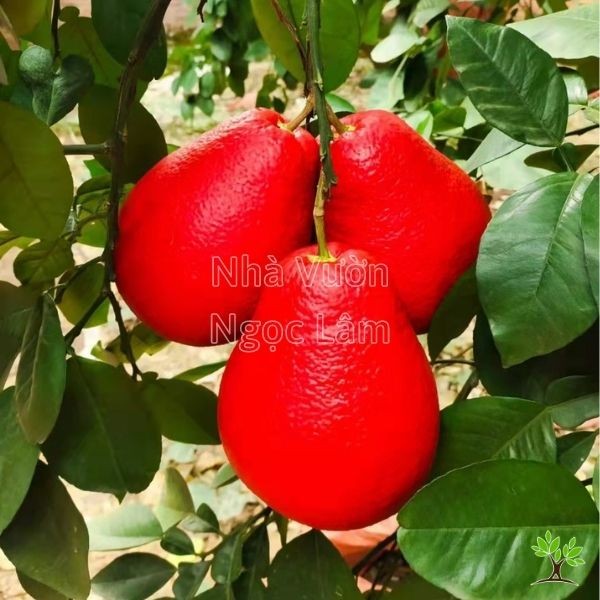 Large, round Thai Red Pomelo fruit with reddish skin
Large, round Thai Red Pomelo fruit with reddish skin
Furthermore, hybrid varieties like the Thai Red Pomelo are still relatively new, leading many farmers to try cultivating them with less competition. Consequently, the economic value of these new varieties can be quite high. Thai Red Pomelo adapts well to the cooler climate of Northern Vietnam, producing many fruits with an extremely attractive red flesh color. The segments inside are very large and incredibly sweet, captivating many discerning palates. Red Pomelo contains up to 15 different types of vitamins along with substances like iron, copper, zinc, antioxidants, and fiber, contributing to its relatively high price.
Waxberry (Myrica rubra)
Waxberry, known as Thanh Mai, is a fruit tree belonging to the wax myrtle family that adapts well to mountainous areas at altitudes of around 2000m or higher above sea level. Therefore, this tree variety is primarily distributed and cultivated in Northern Vietnam.
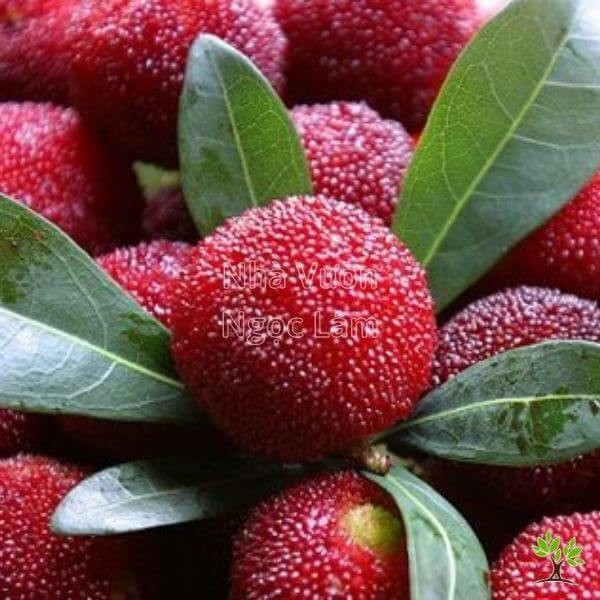 Small, red Waxberry fruits on a branch with green leaves
Small, red Waxberry fruits on a branch with green leaves
Waxberries have round and relatively small fruits. The outer skin has a fuzzy texture that looks somewhat spiky but is actually quite soft. The fruit has a sour, sweet, refreshing, and cool taste with a distinctive aroma and a hard seed. Due to its unique flavor and relatively unfamiliar name to many, this fruit is highly sought after. Waxberries contain many vitamins and organic acids that are quite beneficial for the body. They are considered a good fruit for cooling the body and can be processed into jam, preserves, or wine with a delicious and appealing taste.
Super Early Thai Jackfruit (Artocarpus heterophyllus ‘Super Early Thai’)
Typically, Thai Jackfruit is a very easy tree to grow and adapts to various climates in Vietnam. However, this Super Early Thai Jackfruit variety can develop and thrive best in the climate of Northern Vietnam. This jackfruit variety helps farmers achieve high seasonal yields and brings significant economic value each year.
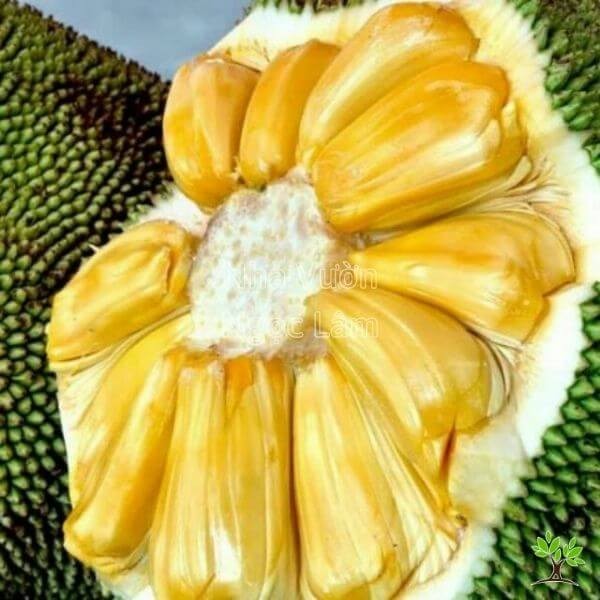 Several large, spiky green Super Early Thai Jackfruit fruits hanging from a tree
Several large, spiky green Super Early Thai Jackfruit fruits hanging from a tree
Currently, northern provinces, particularly Son La, are expanding their jackfruit cultivation models and are transforming this area into one of the largest jackfruit growing regions in the country. Annual profits can reach around 500 million Vietnamese Dong for an orchard of about 300 jackfruit trees. Super Early Thai Jackfruit offers many advantages over traditional jackfruit varieties. The fruits are notably larger in size, and naturally, the weight of each fruit is quite heavy. Therefore, the annual yield is very high. The golden flesh is very sweet, and the thick pulp is another major plus for this jackfruit variety.
Essential Care Tips for Fruit Trees in Northern Vietnam’s Climate
The fruit tree varieties mentioned above are inherently well-adapted to the climate and soil conditions of Northern Vietnam. However, to ensure rapid growth and achieve superior yield and quality, it is important to pay attention to the specific care requirements for each plant variety. Based on our expertise, here are a few key considerations to help you nurture your garden:
- Watering: Provide sufficient water, especially during the dry season. Use mulch like straw around the base of the trees to help retain soil moisture effectively.
- Drainage: Design effective and timely drainage channels, particularly during the rainy season, to prevent waterlogging. The rainy season in Northern Vietnam has high humidity, so less frequent watering may be needed. The natural moisture can often be sufficient for good plant development during this season.
- Fertilization: Increase and apply fertilizer appropriately according to each stage of the tree’s development. This helps boost the tree’s resistance and provides necessary nutrients in a timely manner. Using balanced, high-quality fertilizers from trusted sources is crucial.
Your Source for Quality Seedlings
Finding reliable, high-quality seedlings is the first step to a successful orchard. Biogarden.Asia offers a wide range of fruit tree varieties, including the special and imported types discussed, as well as shade trees and more. All our plant varieties are guaranteed to have clear origins, with seedling quality rigorously checked to ensure they are free from pests and diseases.
The team at Biogarden.Asia is always ready to provide dedicated consultation for the plant varieties you are interested in. Furthermore, we share specific planting and care techniques tailored to each variety, offering valuable insights to help you care for your trees effectively.
When you choose Biogarden.Asia, you can acquire quality seedlings at reasonable prices and benefit from special offers. If you require seedling delivery to your location, we have policies and optimal solutions to ensure the safe transportation and quality of your plants. Contact Biogarden.Asia today to learn more and receive detailed advice!
Biogarden.Asia has shared some of the most recommended fruit tree varieties for cultivation in Northern Vietnam. These varieties have been carefully selected and compiled for their suitability to the region’s conditions. We also provide a wide range of other plant varieties, ensuring quality and robust health that you can explore.



